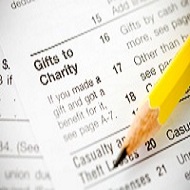Sure it’s a mouthful to try to sing it, but with holiday giving and the record-breaking donations to charities that we have seen since the election, it is time for our annual reminder about the rules governing deductibility of contributions to charities.
Cash Contributions. All cash contributions to charity must be substantiated in order to be deductible. A cash contribution can be substantiated by a receipt or other written communication detailing the name of the tax-exempt organization, the date of the donation and the amount of cash donated. The receipt or writing requirement can be satisfied by a bank statement, a credit card statement, a cancelled check or, in the case of a payroll deduction, by a pay stub or a pledge card detailing the required information.
Non-Cash Contributions under $250. Generally, for non-cash contributions under $250, taxpayers need to have a receipt from the charity showing its name, the date and location of the contribution and a description of the property donated. However, a receipt is not needed if the contribution is made in circumstances where getting a receipt isn’t practical (e.g., dropping off goods at a charity’s unattended donation site). However, in all cases the taxpayer must keep records that include the fair market value of the property at the time of donation and how the taxpayer made that determination.
Non-Cash Contributions of $250 or more. A taxpayer can deduct a contribution of property of $250 or more only if it is substantiated by a “contemporaneous written acknowledgment” from the charitable organization. The contemporaneous written acknowledgment must include:
- a description of the property;
- a statement as to whether the charitable organization provided any goods or services in exchange for the donation; and
- if goods or services were provided, a description and good faith estimate of their value.
Separate contributions of less than $250 to the same charity (e.g., periodic donations to a thrift organization) will not be aggregated for purposes of this rule.
Non-Cash Contributions exceeding $500. In addition to the contemporaneous written acknowledgment, a contribution over $500 also requires the taxpayer to maintain reliable written records regarding how the property was acquired (e.g., by purchase, inheritance or gift etc.), the date of acquisition and the property’s cost or other basis.
Non-Cash Contributions exceeding $5,000. In addition to the contemporaneous written acknowledgment and the reliable written records of how and when the property was acquired and its basis, a contribution over $5,000 also requires the taxpayer to obtain a qualified appraisal of the property. Further, the taxpayer must attach a summary of the appraisal to the taxpayer’s tax return.
For more information on the charitable deduction, including special rules applicable to contributions of conservation easements, capital gain property or marketable securities, check out IRS Publication 526.


